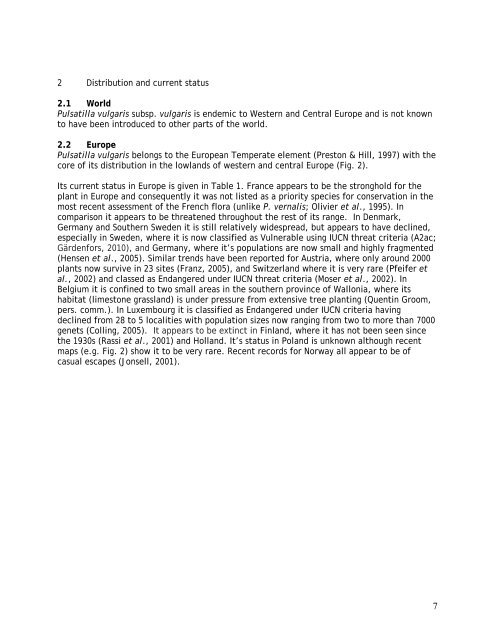Pulsatilla vulgaris (L.) Mill. - Plantlife
Pulsatilla vulgaris (L.) Mill. - Plantlife
Pulsatilla vulgaris (L.) Mill. - Plantlife
Create successful ePaper yourself
Turn your PDF publications into a flip-book with our unique Google optimized e-Paper software.
2 Distribution and current status<br />
2.1 World<br />
<strong>Pulsatilla</strong> <strong>vulgaris</strong> subsp. <strong>vulgaris</strong> is endemic to Western and Central Europe and is not known<br />
to have been introduced to other parts of the world.<br />
2.2 Europe<br />
<strong>Pulsatilla</strong> <strong>vulgaris</strong> belongs to the European Temperate element (Preston & Hill, 1997) with the<br />
core of its distribution in the lowlands of western and central Europe (Fig. 2).<br />
Its current status in Europe is given in Table 1. France appears to be the stronghold for the<br />
plant in Europe and consequently it was not listed as a priority species for conservation in the<br />
most recent assessment of the French flora (unlike P. vernalis; Olivier et al., 1995). In<br />
comparison it appears to be threatened throughout the rest of its range. In Denmark,<br />
Germany and Southern Sweden it is still relatively widespread, but appears to have declined,<br />
especially in Sweden, where it is now classified as Vulnerable using IUCN threat criteria (A2ac;<br />
Gärdenfors, 2010), and Germany, where it’s populations are now small and highly fragmented<br />
(Hensen et al., 2005). Similar trends have been reported for Austria, where only around 2000<br />
plants now survive in 23 sites (Franz, 2005), and Switzerland where it is very rare (Pfeifer et<br />
al., 2002) and classed as Endangered under IUCN threat criteria (Moser et al., 2002). In<br />
Belgium it is confined to two small areas in the southern province of Wallonia, where its<br />
habitat (limestone grassland) is under pressure from extensive tree planting (Quentin Groom,<br />
pers. comm.). In Luxembourg it is classified as Endangered under IUCN criteria having<br />
declined from 28 to 5 localities with population sizes now ranging from two to more than 7000<br />
genets (Colling, 2005). It appears to be extinct in Finland, where it has not been seen since<br />
the 1930s (Rassi et al., 2001) and Holland. It’s status in Poland is unknown although recent<br />
maps (e.g. Fig. 2) show it to be very rare. Recent records for Norway all appear to be of<br />
casual escapes (Jonsell, 2001).<br />
7

















